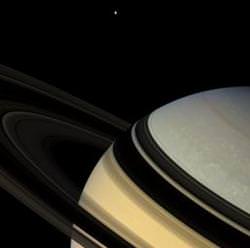
Jia-Rui C. Cook from the Cassini team sent out an alert that raw images from Cassini’s closest flyby of Saturn’s moon Rhea have begun streaming to Cassini’s raw image page, and they are well worth a look. At closest approach, Cassini came within about 69 kilometers (43 miles) of Rhea’s surface on Jan. 11. But there’s also some interesting group photos from within the Saturn System. One of the best is this image, above. How many moons can you find? I probably wouldn’t have seen them all but Emily Lakdawalla at the Planetary Blog spied five moons and the rings in this one wide-angle shot. The large moon is Rhea; above Rhea and just below the rings, is Dione; above and to the left of Rhea is Tethys. Then there are two tiny moons: squint hard to see Prometheus as tiny lump on the rings to the left of Dione, and Epimetheus is hovering between Tethys and Rhea. See some more, including closeups of Rhea and Saturn’s storm, below.






What an awesome flyby! There sure are lots to look at from this pass!
I particularly liked the shot of Rhea’s craters seen at an angle, and then there was a cool close-up of a crater rim that took a second to figure out. Good stuff!
http://lightsinthedark.wordpress.com/2011/01/12/a-close-pass/
Wow!
What is that faint blip below Saturn’s rings but to the right of Rhea and Dione?
Dunno what that is either. Here’s better res version where all moons are clearly visible: http://www.ciclops.org/view_media/33893/Rhea_Rev_143_Raw_Preview_1
Also regarding the storm. On previous Cassini pictures it appeared on northern hem. Now I guess image is just upside down ? It’s nice to see how storm is changing.
The link to the Cassini site doesn’t work at all.
http://www.universetoday.com/82445/stunning-new-images-from-cassinis-close-flyby-of-rhea/he%20storm%20on%20Saturn%20is%20spreading,%20as%20seen%20in%20this%20latest%20image%20taken%20on%20January%2012,%202011%20by%20Cassini.%20Credit:%20NASA/JPL/Space%20Science%20Institute
Fixed — thanks!
You gotta love that spacecraft!
This amazing mission epitomizes what collaboration can accomplish.
Here’s a quick levels adjusted version (using PS curves), to bring out more surface detail:
http://www.robastro.com/temp/rhea.jpg
Exciting times with all of the recent news on UT, whether it be planetary missions, cosmology or phenomena on Earth!
We need more webcams out there around all planets!
In a perfect world there would be trio’s of observational satellites around each of the planets by now…
Ahem.. “… in a more perfect world…”
These images of Saturn & its moons are really fantastic! Bravo for the Cassini imaging team! Hurrahs for Emily also for making the images so easy available to us on her blog & finally for Nancy & her brilliant commentaries as always!